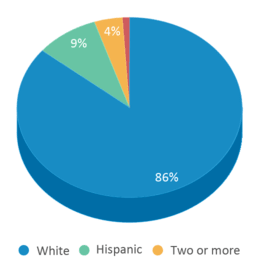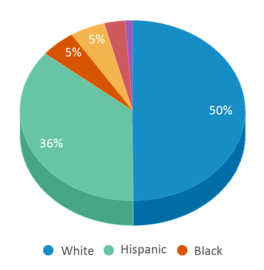Serving 480 students in grades 6-8, West Jefferson Middle School ranks in the top 30% of all schools in Colorado for overall test scores (math proficiency is top 30%, and reading proficiency is top 30%).
The percentage of students achieving proficiency in math is 42% (which is higher than the Colorado state average of 32%). The percentage of students achieving proficiency in reading/language arts is 64% (which is higher than the Colorado state average of 45%).
The student:teacher ratio of 19:1 is higher than the Colorado state level of 15:1.
Minority enrollment is 14% of the student body (majority Hispanic), which is lower than the Colorado state average of 50% (majority Hispanic).
Quick Stats (2025)
- Grades: 6-8
- Enrollment: 480 students
- Student:Teacher Ratio: 19:1
- Minority Enrollment: 14%
- Overall Testing Rank: Top 30% in CO
- Math Proficiency: 42% (Top 30%)
- Reading Proficiency: 64% (Top 20%)
- Science Proficiency: 40-44% (Top 30%)
- Source: National Center for Education Statistics (NCES), CO Dept. of Education
Top Rankings
West Jefferson Middle School ranks among the top 20% of public schools in Colorado for:
Category
Attribute
Reading/Language Arts Proficiency
School Overview
West Jefferson Middle School's student population of 480 students has declined by 16% over five school years.
The teacher population of 25 teachers has declined by 16% over five school years.
Grades Offered
Grades 6-8
Total Students
480 students

Gender %

Total Classroom Teachers
25 teachers

Students by Grade

School Calendar
School Rankings
West Jefferson Middle School ranks within the top 30% of all 1,779 schools in Colorado (based off of combined math and reading proficiency testing data).
The diversity score of West Jefferson Middle School is 0.25, which is less than the diversity score at state average of 0.62. The school's diversity has stayed relatively flat over five school years.
Overall Testing Rank
#357 out of 1779 schools
(Top 30%)
(Top 30%)

Math Test Scores (% Proficient)
42%
32%

Reading/Language Arts Test Scores (% Proficient)
64%
45%

Science Test Scores (% Proficient)
(20-21)40-44%
29%
Student : Teacher Ratio
19:1
15:1

American Indian
n/a
1%

Asian
1%
3%

Hispanic
9%
36%

Black
n/a
5%

White
86%
50%

Hawaiian
n/a
n/a
Two or more races
4%
5%

All Ethnic Groups



Eligible for Free Lunch
16%
39%

Eligible for Reduced Lunch
4%
6%

School Statewide Testing
School District Name
Source: National Center for Education Statistics (NCES), CO Dept. of Education
Profile last updated: 02/09/2025
Frequently Asked Questions
What is West Jefferson Middle School's ranking?
West Jefferson Middle School is ranked #357 out of 1,779 schools, which ranks it among the top 30% of public schools in Colorado.
What schools are West Jefferson Middle School often compared to?
West Jefferson Middle Schoolis often viewed alongside schools like Evergreen Middle School by visitors of our site.
What percent of students have achieved state testing proficiency in math and reading?
42% of students have achieved math proficiency (compared to the 32% CO state average), while 64% of students have achieved reading proficiency (compared to the 45% CO state average).
How many students attend West Jefferson Middle School?
480 students attend West Jefferson Middle School.
What is the racial composition of the student body?
86% of West Jefferson Middle School students are White, 9% of students are Hispanic, 4% of students are Two or more races, and 1% of students are Asian.
What is the student:teacher ratio of West Jefferson Middle School?
West Jefferson Middle School has a student ration of 19:1, which is higher than the Colorado state average of 15:1.
What grades does West Jefferson Middle School offer ?
West Jefferson Middle School offers enrollment in grades 6-8
What school district is West Jefferson Middle School part of?
West Jefferson Middle School is part of Jefferson County School District No. R-1.
School Reviews
2 4/18/2011
It may score well on CSAP, thereby creating a good school report card, but overall we were disappointed by the level of apathy of teachers and administration. Our child felt UNSAFE in school. She was bullied. Teachers were unsupportive, quite clearly demonstrating to us during parent/teacher conferences that they're SUBJECT matter was most important--not children. A unfortunate circumstance to be in.
Watch out for:
1. BULLYING--seems to be rampant but well-hidden.
2. SRO officers who question your child without another adult in the room...and without talking with you first. Isn't that a violation of Civil Rights?
3. APATHY!!! Even when withdrawing our child from the school, no one figured to ask WHY...beyond, please fill out this here form.
If you have a choice, as you do in Colorado, maybe choose another venue--even if it means having to drive your child a little out of the way for another school. At any rate, bus fees per child next year are $150.
Review West Jefferson Middle School. Reviews should be a few sentences in length. Please include any comments on:
- Quality of academic programs, teachers, and facilities
- Availability of music, art, sports and other extracurricular activities
Recent Articles

What Is A Charter School?
Explore the world of charter schools in this comprehensive guide. Learn about their history, how they operate, and the pros and cons of this educational innovation. Discover key facts about charter schools, including admission policies, demographics, and funding, as well as what to look for when considering a charter school for your child.

10 Reasons Why High School Sports Benefit Students
Discover the 10 compelling reasons why high school sports are beneficial for students. This comprehensive article explores how athletics enhance academic performance, foster personal growth, and develop crucial life skills. From improved fitness and time management to leadership development and community representation, learn why participating in high school sports can be a game-changer for students' overall success and well-being.

February 05, 2025
Understanding the U.S. Department of Education: Structure, Impact, and EvolutionWe explore how the Department of Education shapes American education, from its cabinet-level leadership to its impact on millions of students, written for general audiences seeking clarity on this vital institution.





